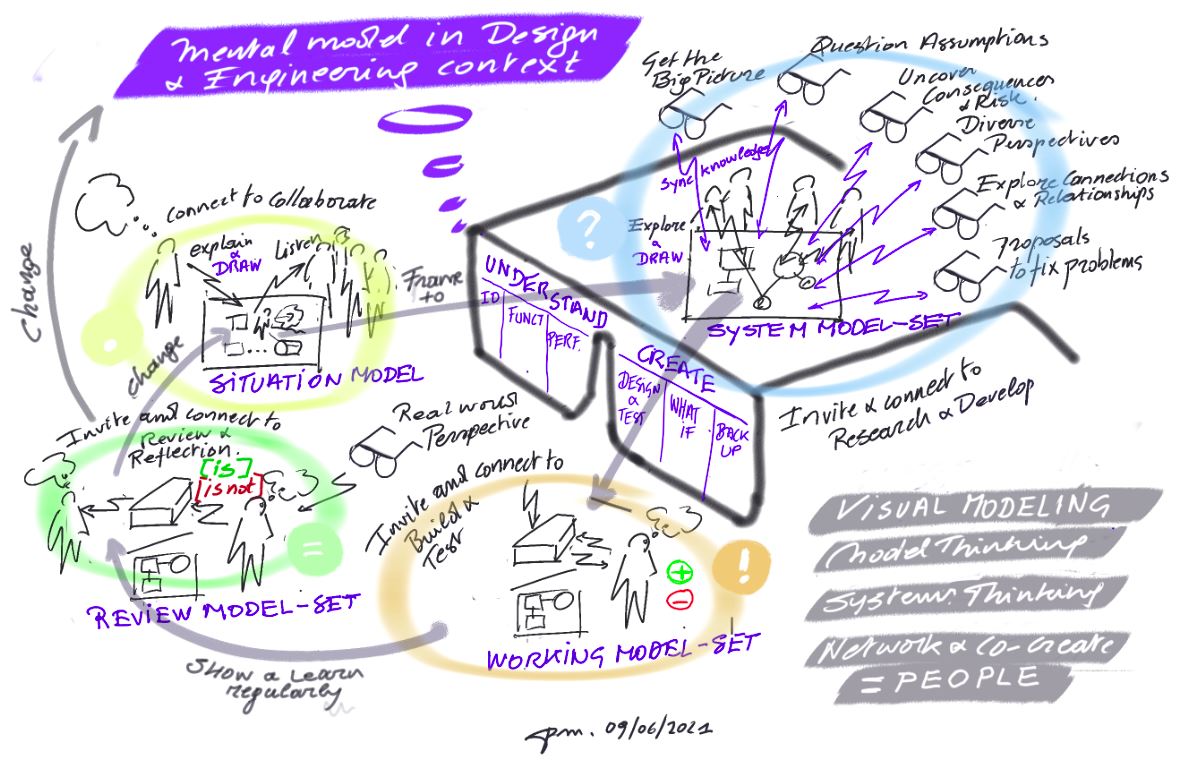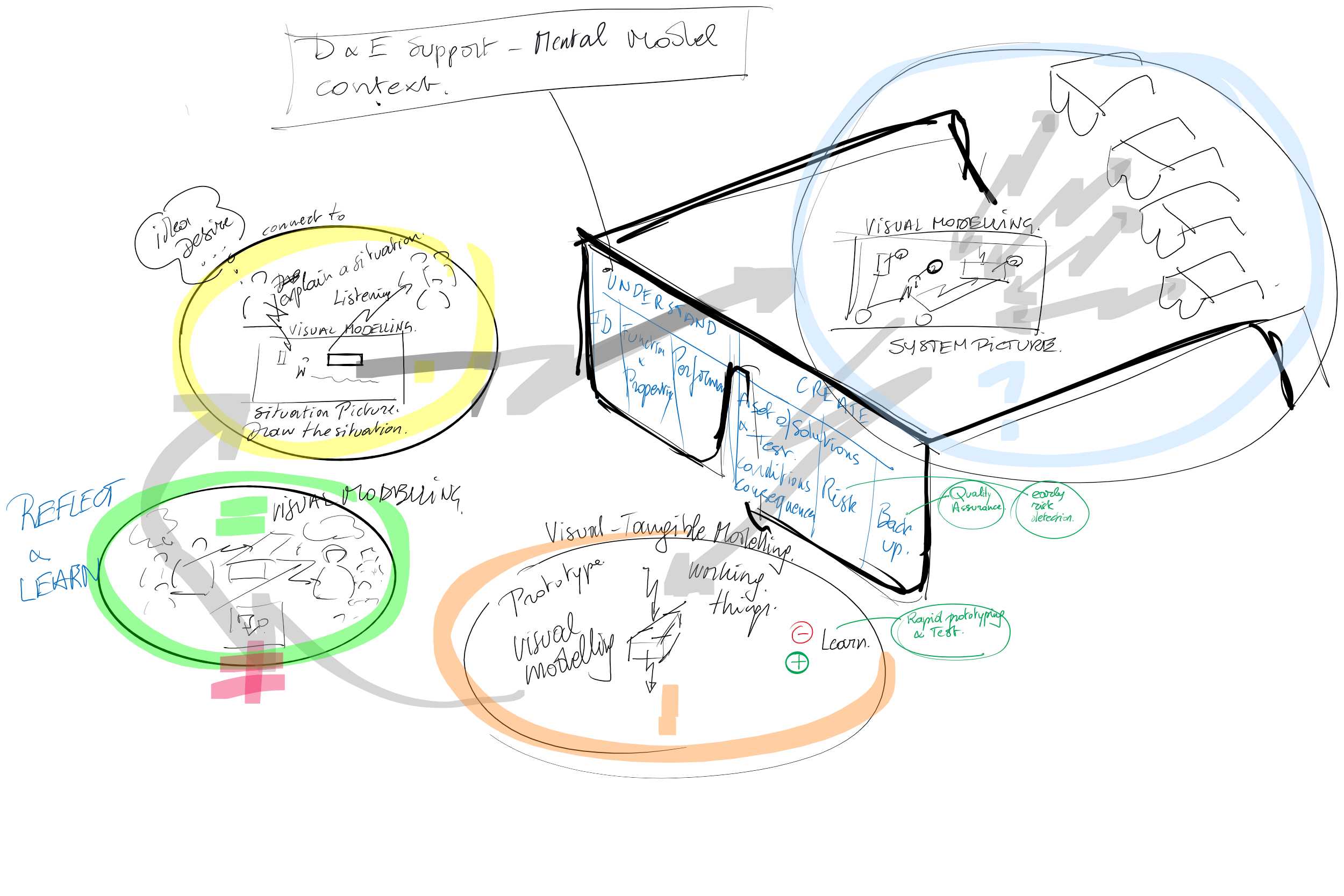What do mental models have to do with orchestrating projects, generating creativity and research, posting knowledge, facilitating implementation, connecting people in co-creation? I want to share with you a mental model that is embedded in a context of product development.
The 'Design & Engineering framework'
I like to introduce you to an individual (experts) and team mental model for use in design related work, appropriate to the domain of exploring system info + creating solutions. It looks like this visual presentation that contains the essentials to guide people to respond with the right action at the right time

The 'Design & Engineering framework' in context
Design situations can be complex. Using a team mental model to explore design situations can help to understand how solution finding evolves and how it is communicated and coordinated in a collaboration.
Shared mental models are important for tasks that require highly coordinated actions between different team members, especially in working conditions where communication is difficult and where work and time pressure is high.
The D&E framework is a mental model to make always good products in Electro-Mech and software projects, used in relationship with:
- Visual modelling (of thoughts about current and desired states of situations, idea’s, problems proposals),
- Model Thinking
- System’s thinking
- Co-creation and networking
In the collaborative mental model for integrated product development as shown in the picture below, the D&E framework is central.

The D&E model is surrounded by other mental models with insight into how they are related and how they are shared or distributed within a team. Two mental models can be recognized:
- team mental models (knowledge about the other team members, their capacities, roles and responsibilities, and how to deal with the different team members)
- individual mental models (a person’s stored knowledge about the specific task
The function and purpose of the D&E framework
The D&E framework frame the questioning of presented situations to transform them to systems models. The systems model becomes the center to discussing the definition of a need and the requirements of a product to facilitate the common understanding within a team. The team shares the systems model (or parts of) for seeking relevant knowledge to create a range of possible solutions.
the framework’s purpose is :
- to share an understanding of the project topics among all project members
- to supports effective and efficient team communication
- allow teams to integrate new information and to make predictions with little mental effort
- enable a person to quickly understand and act even in new and unknown situations
- to coordinate members of a team actions and adapt behaviour to the demands of the task and other team members
The origin of the D&E framework
In the late 1980s, early 1990s, I worked with people from different disciplines with different views and cultures in the context of product development and manufacturing, and two things stood out to me the most:
- the recurring question: “what should things do, why and with what performance” [to do good work]
- and the need to focus on the product [so as not to deviate from the business and operations goal]
I also saw a connection with what I learned from System Engineering, Concurrent Engineering, FME, FMA, Bottleneck Engineering, VE, QFD, DFX, Set-based concurrent engineering, Systems Thinking and the use of Rapid Prototyping.
At the time, in my work as a Design Engineer and Engineering Manager, I was looking for a way to ensure a fast flow and good quality in the product design process to share with teams.
With that need, knowledge and experience I came up with a Design & Engineering Framework, a mental model that makes a combination of separate moments in the design process for: [Understanding] and [Creating]; a framework that supported continuous visual modeling (sketching and CAD exploded views) and systems thinking.
As an artist I knew how created patterns change over time through the effect of thinking differently (from the moment an image is created change is underway) therefore the framework had to be kept simple, and always at hand to be able to adjust it quickly if it didn’t work.
It's relevance and necessity today
Good communication and smart prioritization of actions remain an important challenge in collaborations, agile mental models play an important role in continuing to achieve this.
The D&E framework has been used so far to make good products in Electro-Mech and software projects, and is still relevant and powerful as it is.
The framework components for ‘understanding’ and ‘creation’ are applied in the ‘Visioning-Development-Planning’ technique to develop products, services and systems.
Can you think of any other mental model that you have in product development? Please do mention it in the comments below.


Hi Patrik,
One I find useful is Ishikawa or fishbone. Normally this kind of cause-effect framework is used to help diagnose problems. However it can be used in reverse to map out how to achieve a specific outcome.
At the head of the fish you write the ideal result – at the tail you write the current reality. You identify the main causal thrusts for change and add them as ribs – usually half a dozen or less. Then you can explore the steps within each cause and also how they inter-relate. Eventually you might look at necessary timeframes but that is likely to need a separate diagram.
hi John, fishbone is one of my favorites to be able to do a lot with some creativity, is also good visually to explore in collaborations (also to work remotely). You give an appropriate example of a framework that we should have in our toolbox every day. Thank you for your contribution